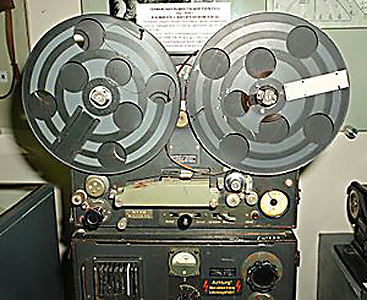|
Processes involved in Manufacturing the tape

Magnetophon from a German radio station in World War II. Courtesy Wikipedia.
The principles underlying the German system of magnetic tape recording, using plastic tape impregnated with iron oxide powders, were described in an article in the June, 1946, issue of this journal. Since then a comprehensive report The Magnetophon Sound Recording and Reproducing System has been published by the British Intelligence Objectives Sub-Committee and is obtainable from HM Stationery Office, price 10/-.
The report presents the findings of a team of investigators - M J L Pulling (BBC), E M Payne (Electrical and Musical Industries) and H E Parker (Ministry of Supply)- and includes circuit diagrams with Component values, recording characteristics with and without correction and detailed descriptions with photographs of the tape-winding mechanism in the principal types of machine.
The methods of manufacturing the various types of tape are given in an appendix with descriptions of the chemical materials used. The latest type LG tape used in high-quality recorders consists of a backing of polyvinyl chloride coated with a layer of ferric oxide powder. The PVC is mixed with titanium white and is rolled into sheets 0.05 mm thick, 60 cm wide and 400 metres long. It is then drawn under tension over electrically heated rollers until it is 0.04 mm thick, 32.5 cm wide and 1 kilometre long, which gives an appreciable increase of tensile strength in a longitudinal direction.
The ferric oxide powder is prepared by precipitating black Fe3O4 oxide from ferrous sulphate with ammonia and then heating the black oxide at 280-300°C to form red-brown Fe2O3. After milling, the powder is air-blown through a sieve to a particle size of 0.2 to 1 micron and is then mixed with an equal quantity of PVC powder and a small quantity of plasticiser and solvent to form lumps 3 to 6 mm diameter for easy handling.
At the coating factory the lumps are milled and made up into a fluid paste with 10 parts benzole and 15 parts tetrahydrofuran to 40 parts iron-oxide mixture. The paste is spread on the film base from a hopper fitted with a mixing paddle, and a bridge piece keeps the layer at the optimum thickness of 0.015 mm. It is found that thicker deposits give a shorter magnetic working range, while a thinner layer results in inadequate magnetization. After coating, the tape is dried in a tunnel through which air at 250°C is drawn, and then in a large drying chamber in which it is wound in a spiral on rollers. The tape takes about 6 minutes to pass through the drying tunnel and chamber.
The coated tape is then slit simultaneously into strips 6.5 mm wide by rotary knives, and after visual inspection electrical tests are made for low background noise and for modulation range at 1,000, 5,000 and 8,000 Hz, the waveform being reproduced on an oscilloscope. The tape can be easily joined, after removing the oxide layer, by the use of cyclo-hexanone as a solvent adhesive.
The report is a mine of information on this highly developed system of recording and contains a bibliography and also a list of relevant patents. There can be no doubt that the use of high-frequency biasing in conjunction with an iron-oxide dispersion as the recording medium is a notable advance in sound recording of which more is likely to be heard in the near future.
|